Emma Lejeune
Towards Robust Surrogate Models: Benchmarking Machine Learning Approaches to Expediting Phase Field Simulations of Brittle Fracture
Jul 09, 2025Abstract:Data driven approaches have the potential to make modeling complex, nonlinear physical phenomena significantly more computationally tractable. For example, computational modeling of fracture is a core challenge where machine learning techniques have the potential to provide a much needed speedup that would enable progress in areas such as mutli-scale modeling and uncertainty quantification. Currently, phase field modeling (PFM) of fracture is one such approach that offers a convenient variational formulation to model crack nucleation, branching and propagation. To date, machine learning techniques have shown promise in approximating PFM simulations. However, most studies rely on overly simple benchmarks that do not reflect the true complexity of the fracture processes where PFM excels as a method. To address this gap, we introduce a challenging dataset based on PFM simulations designed to benchmark and advance ML methods for fracture modeling. This dataset includes three energy decomposition methods, two boundary conditions, and 1,000 random initial crack configurations for a total of 6,000 simulations. Each sample contains 100 time steps capturing the temporal evolution of the crack field. Alongside this dataset, we also implement and evaluate Physics Informed Neural Networks (PINN), Fourier Neural Operators (FNO) and UNet models as baselines, and explore the impact of ensembling strategies on prediction accuracy. With this combination of our dataset and baseline models drawn from the literature we aim to provide a standardized and challenging benchmark for evaluating machine learning approaches to solid mechanics. Our results highlight both the promise and limitations of popular current models, and demonstrate the utility of this dataset as a testbed for advancing machine learning in fracture mechanics research.
Machine Learning-Guided Design of Non-Reciprocal and Asymmetric Elastic Chiral Metamaterials
Apr 19, 2024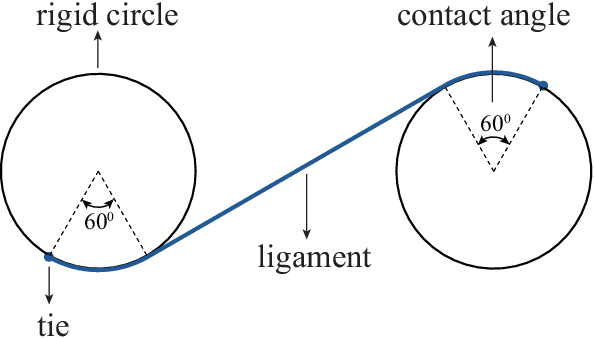

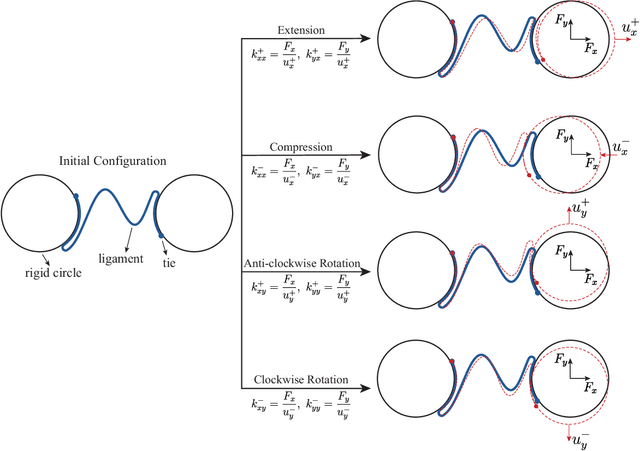
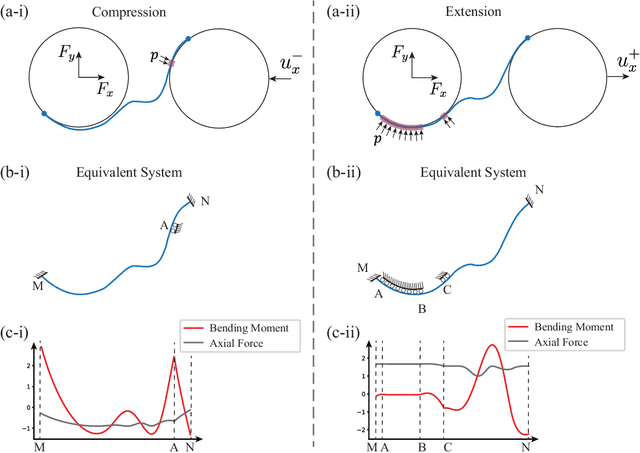
Abstract:There has been significant recent interest in the mechanics community to design structures that can either violate reciprocity, or exhibit elastic asymmetry or odd elasticity. While these properties are highly desirable to enable mechanical metamaterials to exhibit novel wave propagation phenomena, it remains an open question as to how to design passive structures that exhibit both significant non-reciprocity and elastic asymmetry. In this paper, we first define several design spaces for chiral metamaterials leveraging specific design parameters, including the ligament contact angles, the ligament shape, and circle radius. Having defined the design spaces, we then leverage machine learning approaches, and specifically Bayesian optimization, to determine optimally performing designs within each design space satisfying maximal non-reciprocity or stiffness asymmetry. Finally, we perform multi-objective optimization by determining the Pareto optimum and find chiral metamaterials that simultaneously exhibit high non-reciprocity and stiffness asymmetry. Our analysis of the underlying mechanisms reveals that chiral metamaterials that can display multiple different contact states under loading in different directions are able to simultaneously exhibit both high non-reciprocity and stiffness asymmetry. Overall, this work demonstrates the effectiveness of employing ML to bring insights to a novel domain with limited prior information, and more generally will pave the way for metamaterials with unique properties and functionality in directing and guiding mechanical wave energy.
Segmenting mechanically heterogeneous domains via unsupervised learning
Aug 30, 2023



Abstract:From biological organs to soft robotics, highly deformable materials are essential components of natural and engineered systems. These highly deformable materials can have heterogeneous material properties, and can experience heterogeneous deformations with or without underlying material heterogeneity. Many recent works have established that computational modeling approaches are well suited for understanding and predicting the consequences of material heterogeneity and for interpreting observed heterogeneous strain fields. In particular, there has been significant work towards developing inverse analysis approaches that can convert observed kinematic quantities (e.g., displacement, strain) to material properties and mechanical state. Despite the success of these approaches, they are not necessarily generalizable and often rely on tight control and knowledge of boundary conditions. Here, we will build on the recent advances (and ubiquity) of machine learning approaches to explore alternative approaches to detect patterns in heterogeneous material properties and mechanical behavior. Specifically, we will explore unsupervised learning approaches to clustering and ensemble clutering to identify heterogeneous regions. Overall, we find that these approaches are effective, yet limited in their abilities. Through this initial exploration (where all data and code is published alongside this manuscript), we set the stage for future studies that more specifically adapt these methods to mechanical data.
Investigating Deep Learning Model Calibration for Classification Problems in Mechanics
Dec 01, 2022Abstract:Recently, there has been a growing interest in applying machine learning methods to problems in engineering mechanics. In particular, there has been significant interest in applying deep learning techniques to predicting the mechanical behavior of heterogeneous materials and structures. Researchers have shown that deep learning methods are able to effectively predict mechanical behavior with low error for systems ranging from engineered composites, to geometrically complex metamaterials, to heterogeneous biological tissue. However, there has been comparatively little attention paid to deep learning model calibration, i.e., the match between predicted probabilities of outcomes and the true probabilities of outcomes. In this work, we perform a comprehensive investigation into ML model calibration across seven open access engineering mechanics datasets that cover three distinct types of mechanical problems. Specifically, we evaluate both model and model calibration error for multiple machine learning methods, and investigate the influence of ensemble averaging and post hoc model calibration via temperature scaling. Overall, we find that ensemble averaging of deep neural networks is both an effective and consistent tool for improving model calibration, while temperature scaling has comparatively limited benefits. Looking forward, we anticipate that this investigation will lay the foundation for future work in developing mechanics specific approaches to deep learning model calibration.
Towards out of distribution generalization for problems in mechanics
Jun 29, 2022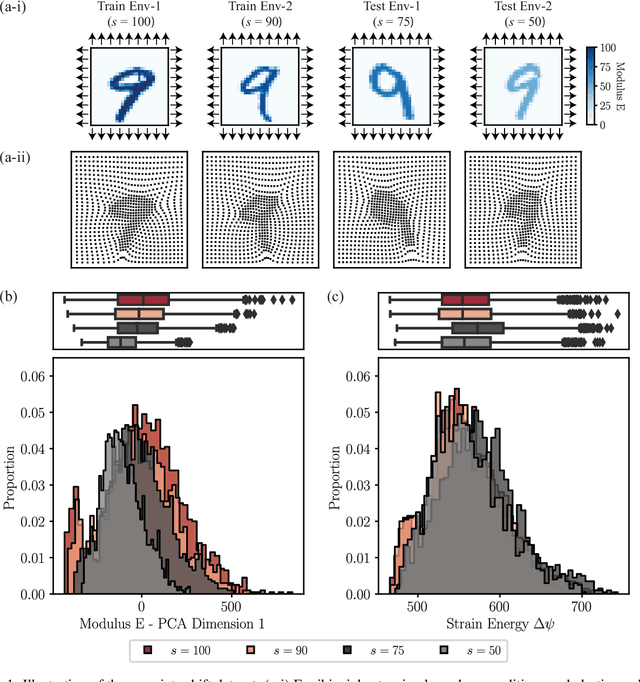
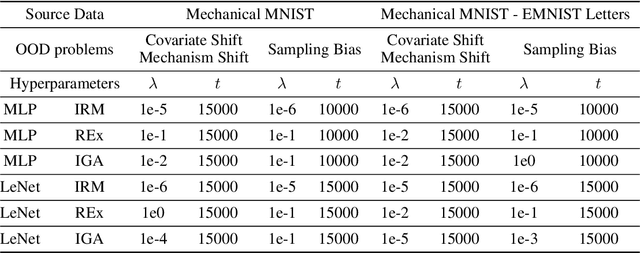

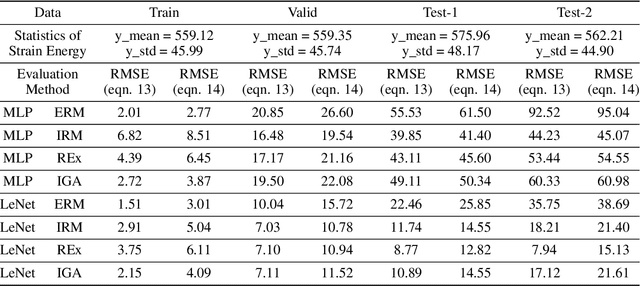
Abstract:There has been a massive increase in research interest towards applying data driven methods to problems in mechanics. While traditional machine learning (ML) methods have enabled many breakthroughs, they rely on the assumption that the training (observed) data and testing (unseen) data are independent and identically distributed (i.i.d). Thus, traditional ML approaches often break down when applied to real world mechanics problems with unknown test environments and data distribution shifts. In contrast, out-of-distribution (OOD) generalization assumes that the test data may shift (i.e., violate the i.i.d. assumption). To date, multiple methods have been proposed to improve the OOD generalization of ML methods. However, because of the lack of benchmark datasets for OOD regression problems, the efficiency of these OOD methods on regression problems, which dominate the mechanics field, remains unknown. To address this, we investigate the performance of OOD generalization methods for regression problems in mechanics. Specifically, we identify three OOD problems: covariate shift, mechanism shift, and sampling bias. For each problem, we create two benchmark examples that extend the Mechanical MNIST dataset collection, and we investigate the performance of popular OOD generalization methods on these mechanics-specific regression problems. Our numerical experiments show that in most cases, while the OOD generalization algorithms perform better compared to traditional ML methods on these OOD problems, there is a compelling need to develop more robust OOD generalization methods that are effective across multiple OOD scenarios. Overall, we expect that this study, as well as the associated open access benchmark datasets, will enable further development of OOD generalization methods for mechanics specific regression problems.
Enhancing Mechanical Metamodels with a Generative Model-Based Augmented Training Dataset
Mar 08, 2022



Abstract:Modeling biological soft tissue is complex in part due to material heterogeneity. Microstructural patterns, which play a major role in defining the mechanical behavior of these tissues, are both challenging to characterize, and difficult to simulate. Recently, machine learning-based methods to predict the mechanical behavior of heterogeneous materials have made it possible to more thoroughly explore the massive input parameter space associated with heterogeneous blocks of material. Specifically, we can train machine learning (ML) models to closely approximate computationally expensive heterogeneous material simulations where the ML model is trained on a dataset of simulations that capture the range of spatial heterogeneity present in the material of interest. However, when it comes to applying these techniques to biological tissue more broadly, there is a major limitation: the relevant microstructural patterns are both challenging to obtain and difficult to analyze. Consequently, the number of useful examples available to characterize the input domain under study is limited. In this work, we investigate the efficacy of ML-based generative models as a tool for augmenting limited input pattern datasets. We find that a Style-based Generative Adversarial Network with an adaptive discriminator augmentation mechanism is able to successfully leverage just 1,000 example patterns to create meaningful generated patterns that can be used as inputs to finite element simulations to augment the training dataset. To enable this methodological contribution, we have created an open access dataset of Finite Element Analysis simulations based on Cahn-Hilliard patterns. We anticipate that future researchers will be able to leverage this dataset and build on the work presented here.
Learning Mechanically Driven Emergent Behavior with Message Passing Neural Networks
Feb 03, 2022



Abstract:From designing architected materials to connecting mechanical behavior across scales, computational modeling is a critical tool in solid mechanics. Recently, there has been a growing interest in using machine learning to reduce the computational cost of physics-based simulations. Notably, while machine learning approaches that rely on Graph Neural Networks (GNNs) have shown success in learning mechanics, the performance of GNNs has yet to be investigated on a myriad of solid mechanics problems. In this work, we examine the ability of GNNs to predict a fundamental aspect of mechanically driven emergent behavior: the connection between a column's geometric structure and the direction that it buckles. To accomplish this, we introduce the Asymmetric Buckling Columns (ABC) dataset, a dataset comprised of three sub-datasets of asymmetric and heterogeneous column geometries where the goal is to classify the direction of symmetry breaking (left or right) under compression after the onset of instability. Because of complex local geometry, the "image-like" data representations required for implementing standard convolutional neural network based metamodels are not ideal, thus motivating the use of GNNs. In addition to investigating GNN model architecture, we study the effect of different input data representation approaches, data augmentation, and combining multiple models as an ensemble. While we were able to obtain good results, we also showed that predicting solid mechanics based emergent behavior is non-trivial. Because both our model implementation and dataset are distributed under open-source licenses, we hope that future researchers can build on our work to create enhanced mechanics-specific machine learning pipelines for capturing the behavior of complex geometric structures.
Exploring the potential of transfer learning for metamodels of heterogeneous material deformation
Oct 28, 2020



Abstract:From the nano-scale to the macro-scale, biological tissue is spatially heterogeneous. Even when tissue behavior is well understood, the exact subject specific spatial distribution of material properties is often unknown. And, when developing computational models of biological tissue, it is usually prohibitively computationally expensive to simulate every plausible spatial distribution of material properties for each problem of interest. Therefore, one of the major challenges in developing accurate computational models of biological tissue is capturing the potential effects of this spatial heterogeneity. Recently, machine learning based metamodels have gained popularity as a computationally tractable way to overcome this problem because they can make predictions based on a limited number of direct simulation runs. These metamodels are promising, but they often still require a high number of direct simulations to achieve an acceptable performance. Here we show that transfer learning, a strategy where knowledge gained while solving one problem is transferred to solving a different but related problem, can help overcome this limitation. Critically, transfer learning can be used to leverage both low-fidelity simulation data and simulation data that is the outcome of solving a different but related mechanical problem. In this paper, we extend Mechanical MNIST, our open source benchmark dataset of heterogeneous material undergoing large deformation, to include a selection of low-fidelity simulation results that require 2-4 orders of magnitude less CPU time to run. Then, we show that transferring the knowledge stored in metamodels trained on these low-fidelity simulation results can vastly improve the performance of metamodels used to predict the results of high-fidelity simulations.
 Add to Chrome
Add to Chrome Add to Firefox
Add to Firefox Add to Edge
Add to Edge